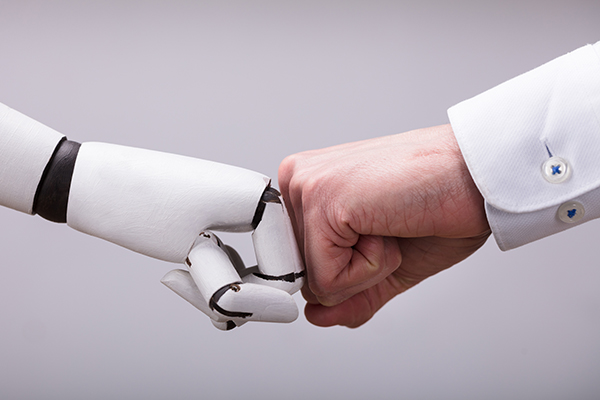Holy robots!
It seems that most everywhere you look in the past couple of months there are robots. And they are almost always doing something new.
To start, look at the news coming out of the ProMat and Automate shows in April, where robots dominated even though there were many more than 1,000 exhibitors with supply chain solutions. The introductions ranged from collaborative robots to pick-and-place to autonomous mobile robots and beyond. Artificial intelligence and cloud-based systems figured prominently too.
Meanwhile, you now have to watch out for mobile robots at your local store. When you go to Walmart, look for robots taking inventory storewide. Ditto for grocer Giant Eagle. Robots in the personal care and pasta aisles? Really? It's happening now.
Of course, Amazon's bots continue to proliferate to fill your e-commerce orders. Meanwhile, Ryder Systems is cycle counting in its smart warehouses with robots from Fetch Robotics. Hollar, which offers products starting at $1 online, has deployed inVia Picker robots at its new Cincinnati warehouse.
Don't overlook companies like family-owned national 3PL Barrett Distribution. It's using Locus Robotics' order picking robots to fill orders at its facility in Franklin, MA. “This most recent busy season we were able to utilize the bots to ship a record number of packages with less head count than we've had before,” explains Doug Varga, vice president information technology at Barrett.
That puts robots in a nutshell – higher throughput with less labor. But don't expect people to go away. Collaborative robots, those that work alongside people in the warehouse especially, are at the top of people's cap ex budgets these days.
All this robotics technology is having an impact.
“Industry is making the transition from fixed automation to robotics,” says Christopher Barber, CEO of North America at intelligent robotics supplier GreyOrange. “We are at a juncture very similar to the mid-1980s when computers were first taking their place in manufacturing and distribution. Clearly, big changes are coming,” Barber adds.
Demand for robots is expected to be strong for the foreseeable future. ABI research expects today's automated warehouses worldwide to climb from 4,000 to 50,000 by 2023. The firm says those facilities will have four million robots.
The International Federation of Robotics projects 14% annual growth in robot sales globally through 2021. In North America, non-automotive robot sales were up 17% last year over 2017, explains Jeff Burnstein, president of the Association for Advancing Automation, in this month's NextGen: The Interview.
Just as important, venture capital is flowing to robot startups. GreyOrange raised $140 million last year, bringing the total raised to $170 million. Meanwhile, Locus Robotics raised an additional $26 million last month, bringing total funding to nearly $70 million. Those are just two examples.
Here's what a recent investor in Fetch Robotics had to say. “The warehouse and automation market is estimated at over $40 billion today, and is poised to double over the next five years. Our investment in Fetch complements and extends our portfolio of exceptional leaders who are transforming the global supply chain,” says Brian Nugent, founding general partner at Sway Ventures.
Innovation is leading the way here. Clearly, there is nothing static about robots these days. Not only are they mobile but many are incorporating artificial intelligence to enhance performance and efficiency over time.
At the ProMat show, RightHand Robotics received the Innovation Award for best innovation of an existing product. The company introduced its RightPick2, an integrated software and hardware platform. The autonomous piece-picking platform incorporates new skills using artificial intelligence enabled vision and motion control software with deep learning.
Here are four other recent examples of new introductions of mobile robots with AI from the recent shows.
InVia offers a cloud-based robotics-as-a-service management system for its robots. The artificial intelligence-based system learns the warehouse and improves processes over time.
Vecna recently introduced its AI-based platform for coordinating workflow of piece-picking robots and people. It analyzes current operations and adjusts processes within pre-set norms.
Boston Dynamics has acquired Kinema Systems that enables industrial robotic arms with deep learning technology to locate and move boxes on pallets.
Geek+ introduced autonomous mobile robots for warehousing and order fulfillment. They are powered by machine learning to improve picking and inventory accuracy.
These and other robots already do or will someday communicate with the cloud, which opens up a new horizon. “I fully expect that learning will be shared across a fleet of robots using cloud communications,” says A3's Burnstein. “That will continuously upgrade the capabilities of robots if not in real time, in near real time,” he adds.
It seems that as robots meet up with the cloud, the sky's the limit for this NextGen technology.
Gary Forger is special projects editor for Supply Chain Management Review. He can be reached at [email protected].
SC
MR


More Robotics
- Humanoid robots’ place in an intralogistics smart robot strategy
- Mobile Robots Leading the Hype Battle with Drones
- Generative AI, Robotics and Automation: Supply Chain Friends or Foes?
- MassRobotics announces winner of Robotics Medal, names Rising Star
- Let’s Talk Mobile Robots: Three Real-World Applications for Warehouse and Manufacturing
- Industry first: One million robots on the job in automotive
- More Robotics
Latest Resources

 Explore
Explore
Topics
Software & Technology News
- AI, virtual reality is bringing experiential learning into the modern age
- Humanoid robots’ place in an intralogistics smart robot strategy
- Tips for CIOs to overcome technology talent acquisition troubles
- Game on: Rethinking change management for the digital era
- Predicting stockouts: Enhancing FMCG resilience through data-driven insights
- Top Performers Investing in, Benefitting from AI
- More Software & Technology
Latest Software & Technology Resources

Subscribe

Supply Chain Management Review delivers the best industry content.

Editors’ Picks




